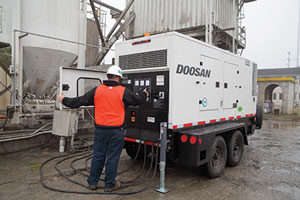But just having a mobile generator on site isn’t enough. An improperly sized generator can fail, trip circuits and damage the equipment being powered. A properly sized generator, on the other hand, keeps productivity high and costs low.
How do you properly size a generator?

|
| A mobile generator can be the beating heart of a drilling jobsite, so it needs to be sized properly for the job at hand. Source: Doosan Portable Power |
Sizing a Non-Motorized Application
For non-motorized applications, it’s important to know the voltage and amperage (amps) requirements of the equipment. This information is used to determine kilowatts (kW), which is the amount of electrical power needed to operate the load. Voltage and amps and power factor information can typically be found on the equipment data plate.
In North America, most generators are rated in kilo-volt-ampere (kVA) rather than kW. To convert kW to kVA, divide the kW by the power factor (PF) of the equipment. Typically, most single-phase applications and non-motorized applications (such as lighting or heaters) have a power factor of 1.0, whereas three-phase applications and motors typically have a power factor between 0.8-0.95.
volts x amps = watts/1000 = kW/PF = kVA
Match the kVA figure with the generator specifications to determine if the unit will provide the necessary kVA, kW and amps at the correct voltage required by the application.
To power more than one application, the total amperage for all pieces of equipment should be added and multiplied by the volts. For example, a customer needs to power 10 lights. Each light requires 10 amps and 230V and is assumed to be 1.0PF.
10 lights x 10 amps each = 100 amps
100 total amps x 230V = 23,000/1000 = 23 kW/1.0 = 23 kVA
Remember, the appropriate generator cannot be based on kVA only. An appropriate generator must meet kVA, amperage and voltage requirements of the application.
Motorized Applications
Powering electric motors is a very common application for mobile generators, but requires slightly more complex calculations to achieve the correct selection. These applications require more power to start the motor than is required to keep it running, so we introduce a new calculation called starting kVA (SkVA). Again, the equipment data plate provides most of the information to perform the calculations. Key data includes motor horsepower, voltage, full load amps and motor starting code. In addition, it is important to know a bit about the motor starting controls. While it is quite common to see “across the line” starters, this type of starting control results in the highest impact on the generator and typically requires a larger generator. If the application includes a “soft starter,” it can significantly reduce the starting impact and often results in the selection of a smaller generator than would be required for an “across the line” application.
SkVA is calculated by multiplying the motor code by the horsepower and applying a factor for the type of motor starter. Motor code tables and starter factors can be found with a standard Internet search or by contacting your generator manufacturer. The most common motor code G and “across the line” starter type can be used when the information is not readily available on the data plate. Motor code G is 6.29 kVA, while across the line starter factor is 1.0.
Motor code x starter factor x HP = SkVA
Match the application’s required SkVA to the product specifications to ensure the requirements are met.
If the generator will be powering more than one motor application at a time, sizing will be based on the sequence in which the applications are started. If the applications are started together, add up the total SkVA for all three motors.
500 SkVA + 350 SkVA + 100 SkVA = 950 SkVA
If the applications will be started in a sequence, calculate the SkVA for each application. If possible, the starting sequence should start the motors beginning with the largest first. Include the amps and kVA for each application.
Add the kVA of the first application to the SkVA of the next application in the sequence. Continue adding kVA to SkVA until all applications are included.
100 kVA to run first application + 350 SkVA to start second application = 450 kVA
168 kVA to run application 1 and 2 + 100 SkVA to start the third application = 268 kVA
Calculate the total amps required by all applications.
180 + 100 + 22 = 302 amps
In this instance, a properly sized generator must output at 500 SkVA, 218 kVA and 302 amps.
Todd Howe is global generator products manager at Doosan Portable Power.





Report Abusive Comment